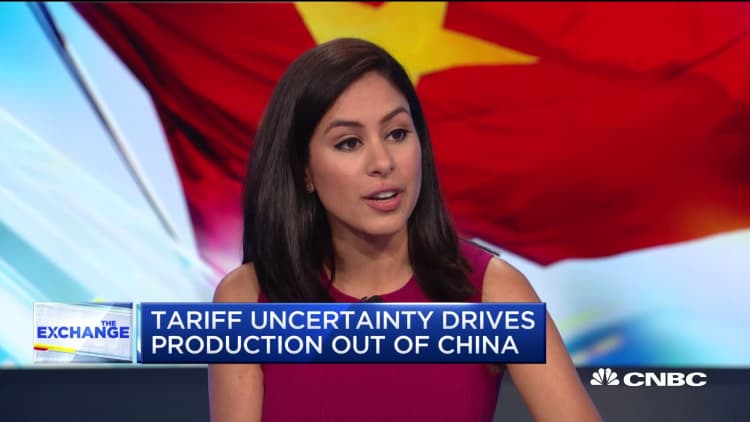U.S. and Chinese negotiators wrapped up a brief round of trade talks on Wednesday that Beijing described as "constructive," including discussion of further purchases of American farm goods and an agreement to reconvene in September.
The first face-to-face trade talks since a ceasefire was agreed last month amounted to a working dinner on Tuesday at Shanghai's historic Fairmont Peace Hotel and a half-day meeting on Wednesday, before U.S. Trade Representative Robert Lighthizer and Treasury Secretary Steven Mnuchin flew out.
"Both sides, according to the consensus reached by the two leaders in Osaka, had a candid, highly effective, constructive and deep exchange on major trade and economic issues of mutual interest," China's Commerce Ministry said in a statement shortly after the U.S. team left Shanghai.
The statement said negotiators discussed more Chinese purchases of agricultural products from the United States, which had become a bone of contention after U.S. President Donald Trump said China had not delivered on promised purchases.
The talks began amid low expectations, with Trump on Tuesday accusing Beijing on Twitter of stalling, and warning of a worse outcome for China if it continued to do so.
On Wednesday, Chinese Foreign Ministry spokeswoman Hua Chunying said that she was not aware of the latest developments during the talks, but that it was clear it was the United States that continued to "flip flop."

"I believe it doesn't make any sense for the U.S. to exercise its campaign of maximum pressure at this time," Hua told a news briefing in response to a question about the tweets.
"It's pointless to tell others to take medication when you're the one who is sick," she said.
The two sides will reconvene in September in the United States, the Commerce Ministry said.
The U.S. side did not make an immediate statement.
Early finish
The protracted trade war between the world's two largest economies has disrupted global supply chains and shaken financial markets as each side has slapped tariffs on billions of dollars of each other's goods.
An official Chinese government survey released on Wednesday showed factory activity shrank for the third month in a row in July, underlining the growing strains the row has placed on the No. 2 economy.
The Shanghai talks were expected to centre on "goodwill" gestures, such as Chinese commitments to purchase U.S. agricultural commodities and steps by the United States to ease some sanctions on Chinese telecoms equipment giant Huawei Technologies Co Ltd, a person familiar with the discussions told Reuters earlier.
Those issues are somewhat removed from the more core U.S. complaints in the trade dispute, including Chinese state subsidies, forced technology transfers and intellectual property violations.
'No deal is fine'
As talks were just beginning on Tuesday, Trump said on Twitter that China appeared to be backing off on a pledge to buy U.S. farm goods, and he warned that if China stalled negotiations in the hope that he wouldn't win re-election in the November 2020 U.S. presidential contest, the outcome would be worse for China.
"The problem with them waiting ... is that if & when I win, the deal that they get will be much tougher than what we are negotiating now ... or no deal at all," Trump said.
Trump and Chinese President Xi Jinping agreed in June at the G-20 summit in Osaka, Japan, to restart trade talks that stalled in May, after Washington accused Beijing of reneging on major portions of a draft agreement. The collapse in talks prompted a steep U.S. tariff hike on $200 billion of Chinese goods.
The U.S. Commerce Department put Huawei on a national security blacklist in May, effectively banning U.S. firms from selling to Huawei, a move that enraged Chinese officials.
Trump said after the Osaka meeting that he would not impose new tariffs on a final $300 billion of Chinese imports and would ease some U.S. restrictions on Huawei if China agreed to make purchases of U.S. agricultural products.
But so far, U.S. semiconductor and software makers are still mostly in the dark about the administration's plans.
In Sao Paulo on Tuesday, U.S. Commerce Secretary Wilbur Ross said decisions on license applications by U.S. firms to resume some sales to Huawei could come as early as next week.
Hu Xijin, editor-in-chief of China's nationalistic Global Times tabloid, run by the ruling Communist Party's People's Daily newspaper, wrote on Twitter that the negotiators had "efficient and constructive" exchanges.
"The two sides discussed increasing purchase of U.S. farm products and the U.S. side agreed to create favourable conditions for it. They will hold future talks," Hu said, without elaborating.
Earlier, the Global Times said if Washington still holds the illusion that Beijing will somehow cave in and compromise on issues concerning sovereignty, "then no deal is fine."

